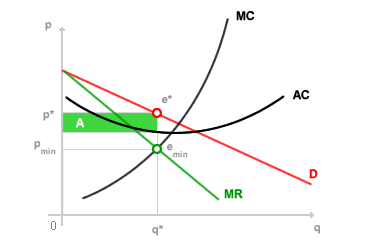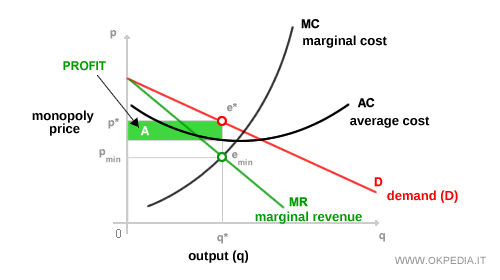Monopoly
A monopoly is a market structure with no real competition, where a single firm controls the entire supply of a good or service, while demand is spread across many buyers. Since there are no substitute goods or rival producers, the monopolist can set the selling price at will, leaving consumers with no genuine alternatives.
Why is there only one firm in a monopoly? Entry by potential competitors is blocked by technological, legal, or natural barriers (types of monopoly). As a result, the monopolist remains the sole supplier in the market.
Monopoly Pricing
A monopolist can determine the price of its product in two different ways:
- Indirect method. The firm chooses the level of output (Qs), and the market then establishes the price (P) that balances supply and demand.

- Direct method. The firm sets the selling price (P) directly, while buyers decide how much they are willing to purchase (Qd). The firm then adjusts its production (Qs) to match demand, keeping the price unchanged.

In both scenarios, it is the monopolist who chooses the exact point on the demand curve at which to operate.
Monopolies vs. Competitive Firms
A monopolist has control over both the price charged and the quantity supplied.
Competitive firms, on the other hand, are price takers: they cannot set prices themselves but must accept the price dictated by the competitive market.
 Like in perfect competition, market demand in a monopoly comes from many individual buyers. The difference is that only the monopolist can meet that demand. For this reason, the monopolist's demand curve slopes downward.
Like in perfect competition, market demand in a monopoly comes from many individual buyers. The difference is that only the monopolist can meet that demand. For this reason, the monopolist's demand curve slopes downward.
Monopoly Equilibrium
Monopoly equilibrium can be represented on the following Cartesian graph:

A monopoly reaches equilibrium when the firm maximizes its profit (profit maximization). The condition for maximum profit is that marginal revenue (MR) equals marginal cost (MC).
MR = MC
Profit is maximized at point emin, where the marginal cost (MC) curve intersects the marginal revenue (MR) curve. This point determines the profit-maximizing output level q*. At that quantity, the market demand curve sets the corresponding market price p*.

Given the average cost of production (AC), the monopolist secures a profit equal to the green area A in the diagram.
In essence, a monopolist maximizes profit by deliberately restricting output in order to drive prices higher. This allows the firm to capture an extra profit (monopoly rent), measured by the gap between the selling price (p) and the average cost (AC).
 Consumers have no choice but to accept the monopolist's terms, since no competing firms are available to meet their needs. The monopolist is the only provider in the market.
Consumers have no choice but to accept the monopolist's terms, since no competing firms are available to meet their needs. The monopolist is the only provider in the market.
The Monopoly Equilibrium Formula
In a monopoly, the marginal revenue from selling an additional unit of output is always lower than the market price (P).
Marginal revenue (MR) varies inversely with the price elasticity of demand (e).

 The less elastic demand is with respect to price (−Δe), the wider the gap between price and marginal revenue (P − MR > 0). When demand is perfectly elastic (e = ∞), price coincides with marginal revenue (P = MR), exactly as in perfect competition.
The less elastic demand is with respect to price (−Δe), the wider the gap between price and marginal revenue (P − MR > 0). When demand is perfectly elastic (e = ∞), price coincides with marginal revenue (P = MR), exactly as in perfect competition.
Thus, the monopolist’s profit-maximization condition (MC = MR) can be reformulated as follows:

This equality between marginal cost and marginal revenue can also be rearranged to express price explicitly as a function of the other variables:

 The term 1/(1 − 1/e) represents the monopolist’s market power, which determines the size of its mark-up over marginal cost.
The term 1/(1 − 1/e) represents the monopolist’s market power, which determines the size of its mark-up over marginal cost.
Unlike a competitive firm, a monopolist can charge a selling price (p) above marginal cost (MC).
For this reason, the monopolist chooses the point on the demand curve where its market power - and therefore its mark-up - is greatest.
- Inelastic demand. On the inelastic segment of the demand curve, elasticity (e) lies between 0 and 1 (0 < e < 1). In this range, the formula implies negative marginal revenue, making it economically irrelevant. In the table below, market power is calculated for elasticity values below 1: because market power is negative, all marginal revenues are negative as well.

- Elastic demand. When demand is elastic (e > 1), marginal revenue (MR) is positive. Market power is inversely related to elasticity: the less elastic the demand, the greater the gap between price (p) and marginal cost (MC). The table below shows market power for elasticity values above 1. Prices remain positive, and the lower the elasticity, the higher the price. At e = 1.2, the monopolist achieves the maximum mark-up over marginal cost.

In summary, a monopolist maximizes profit by operating only on the elastic portion of the demand curve, where e > 1 and the difference between price (p) and marginal cost (MC) is at its largest.
 Demand elasticity in a monopoly is inversely related to the degree of monopoly power. The lower the elasticity of demand, the stronger the monopoly power - and the higher the firm’s profit.
Demand elasticity in a monopoly is inversely related to the degree of monopoly power. The lower the elasticity of demand, the stronger the monopoly power - and the higher the firm’s profit.
The Allocative Inefficiency of Monopoly
Monopoly leads to a misallocation of resources compared with more competitive market structures.
To maximize profit, a monopolist reduces output in order to push up the selling price.
As a result, the volume of trade in a monopoly is lower than in perfect competition.
How to Measure Allocative Inefficiency
Comparing the competitive equilibrium with the monopoly equilibrium provides a clear measure of the allocative inefficiency created by monopoly power.
 In a perfectly competitive market, the total surplus enjoyed by all economic agents is maximized. This outcome represents the highest level of allocative efficiency and overall welfare, serving as the benchmark against which monopoly performance is judged.
In a perfectly competitive market, the total surplus enjoyed by all economic agents is maximized. This outcome represents the highest level of allocative efficiency and overall welfare, serving as the benchmark against which monopoly performance is judged.
The two equilibria can be illustrated on a Cartesian diagram:

- At the perfectly competitive equilibrium (eC), qC units are exchanged at the market price pC. Total surplus corresponds to the sum of the green areas A + B + C + D.
- At the monopoly equilibrium (eM), only qM units are sold at the higher price pM. Here, total surplus is reduced to areas A + B.
The difference between total surplus under perfect competition (A + B + C + D) and under monopoly (A + B) measures the deadweight loss generated by monopoly power.

In the diagram above, the shift from competition (eC) to monopoly (eM) results in a deadweight loss equal to the area C + D.
